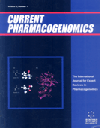- Home
- A-Z Publications
- Current Pharmacogenomics
- Previous Issues
- Volume 4, Issue 2, 2006
Current Pharmacogenomics - Volume 4, Issue 2, 2006
Volume 4, Issue 2, 2006
-
-
Gene Therapy by Liver Transplantation and Single Stranded Oligonucleotides (SSOs) in Familial Amyloidotic Polyneuropathy (FAP)
More LessAuthors: Yukio Ando and Masaaki NakamuraLiver transplantation has been considered as a promising therapy to halt the progression of clinical symptoms of progression in familial amyloidotic polyneuropathy (FAP) because most of transthyretin (TTR) is produced by the liver. In addition, domino liver transplantation using an FAP patient's liver has been performed because of shortage of domor livers. However, the use of liver transplantation as therapy for familial amyloido Read More
-
-
-
Information of ADME-Associated Proteins and Potential Application for Pharmacogenetic Prediction of Drug Responses
More LessAuthors: C. J. Zheng, L. Y. Han, X. Chen, Z. W. Cao, J. Cui, H. H. Lin, H. L. Zhang, H. Li and Y. Z. ChenPharmacogenetic prediction and mechanistic elucidation of individual variations of drug response is important for facilitating the development of personalized medicines and optimum therapeutic dosages. One of the keys to pharmacogenetic studies is the knowledge about proteins responsible for the absorption, distribution, metabolism and excretion (ADME) of drugs. This article describes the web-resources of ADM Read More
-
-
-
Pharmacogenetics, Target Molecules, and Biological Anti-Rheumatic Drugs in Autoimmune/Chronic Inflammatory Rheumatic Diseases
More LessAuthors: G. Ferraccioli, B. Tolusso and M. De SantisAutoimmune chronic rheumatic inflammatory diseases are polygenic illnesses in which the inflammatory process mainly occurs in the synovial tissue, surrounding the joints. Dozens of inflammatory genes are upregulated or downregulated in each rheumatic disease. The genes of several of the molecules synthesized are often polymorphic and some of these polymorphisms have clearly been shown to be functionally relevant Read More
-
-
-
Pharmacogenetic Aspects of Neuroleptic Malignant Syndrome
More LessAuthors: Chiaki Kawanishi, Ikuko Kishida, Taku Furuno, Daiji Kato and Leif BertilssonNeuroleptic malignant syndrome (NMS), a potentially life-threatening adverse reaction to neuroleptic drugs, is characterized by hyperthermia, extrapyramidal signs, altered consciousness, and autonomic disturbances. Even atypical antipsychotic drugs, considered to carry less risk of adverse reactions than conventional agents, nonetheless can cause NMS. While central dopaminergic pathways have been regarded as Read More
-
-
-
Detection of Known Mutations with DNA Polymerases: Its Pharmacogenetic Applications
More LessAuthors: Jia Zhang, Cuilan Zhou, Yufang Yin, Linling Chen, Jose R. Pardinas, Tingting Liu, Hanlin Gao, Juan-Sebastian Saldivar and Kai LiThe changes in physical and chemical characteristics derived from genetic alteration are the basis for the development of mutation assays. Among the ever-increasing number of mutation assays available, most are variants of allele-specific primer extension targeting single nucleotide polymorphism (SNP) and point mutations. Conventional allele-specific primer extension was designed to work using exo- polymerases ex Read More
-
-
-
Genetic Variation at the Human MGMT Locus and its Biological Consequences
More LessAuthors: G. P. Margison, A. C. Povey and M. Santibanez-KorefO6-alkylguanine-DNA alkyltransferase (MGMT) repairs DNA adducts that result from alkylation at the O6 position of guanine. These lesions are mutagenic and toxic and can be produced by a variety of agents ranging from carcinogens present in cigarette smoke to drugs used in cancer chemotherapy. There is a considerable amount of interindividual variation of MGMT activity and recent work has uncovered a series of p Read More
-
-
-
Fish Pharming: Identifying Gene Function and Therapeutic Targets Using Pharmacologic Treatment of Zebrafish Embryos
More LessAuthors: M. Kamkar, M. A. Steggles and C. C. MartinOne of the remaining challenges for the post-genomic era researcher is the systematic assignment of gene function to a sequenced genome. The zebrafish is an effective model organism for conducting comparative analyses of the human genome. The ability to obtain large numbers of zebrafish embryos, grow them in a 96-well dish, and then expose them to molecules dissolved in their water, underline the valuable cha Read More
-
-
-
Clinical Importance of Calcium-Sensing Receptor Gene Polymorphism Arg990Gly in the Age of Calcimimetic Therapy
More LessAuthors: Hansjorg Rothe and Gert MayerCinacalcet HCl is the first calcimimetic agent available for the therapy of secondary hyperparathyroidism (sHPT) and palliative treatment of parathyroid carcinoma. It acts on the extracellular calcium-sensing receptor (CaSR) as an allosteric activator, i.e. it leads to responses as if hypercalcaemia was present, in the face of normal or even low serum calcium levels. Its most important effect is the suppression of PT Read More
-
-
-
Prospect of Individualized Medicine in Chronic Hepatitis C Therapy by Pharmacogenomics
More LessAuthors: Yuchi Hwang, Chunlin Su, Ding-Shinn Chen and Pei-Jer ChenInterferon-α and ribavirin combination therapy has been the current choice for treating chronic hepatitis C (CHC) patients. The treatment takes 6 to 12 months but the overall sustained response rate is only around 50% and often brings significant adverse effects to some patients. The treatment outcome has been shown to be associated with various viral factors, such as viral loads before and during treatment and, most importa Read More
-
-
-
Effect of Brain Derived Neurotrophic Factor (BDNF) Gene Variants on Therapeutic Response and the Risk for Schizophrenia
More LessAuthors: Shih-Jen Tsai and Chen-Jee HongEarly maldevelopment of brain tissue has been postulated as a crucial factor in the pathogenesis of schizophrenia. The neurotrophin brain-derived neurotrophic factor (BDNF) is widely and abundantly expressed in mammalian brain. BDNF plays important role in the development of brain and has critical effects on the differentiation of monoaminergic neurons. In rodents, antipsychotic treatments have been shown to alter the Read More
-
Most Read This Month
Article
content/journals/cpg
Journal
10
5
false
en


